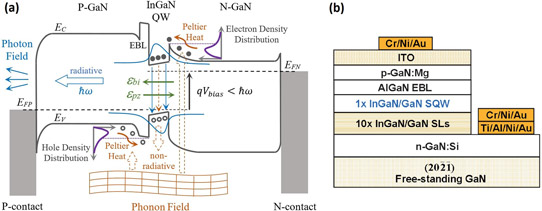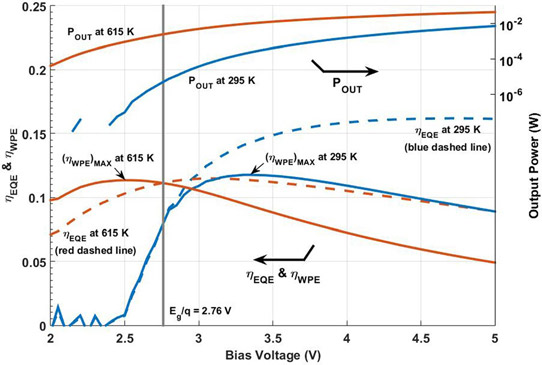- News
12 October 2015
Thermoelectric pumping enhancement for blue light-emitting diodes
Massachusetts Institute of Technology (MIT) and University of California Santa Barbara (UCSB) in the USA have been investigating the possibility of taking advantage of high temperature and thermoelectric pumping to improve the light output power (LOP) from indium gallium nitride (InGaN) light-emitting diodes (LEDs), avoiding the need for external cooling [Jin Xue et al, Appl. Phys. Lett., vol107, p121109, 2015].
The researchers write: "The LED is shown to work in a mode similar to a thermodynamic heat engine operating with charged carriers pumped into the active region by a combination of electrical work and Peltier heat (phonons) drawn from the lattice."
The team says that their results suggest the possibility of removing bulky heat sinks in commercial high-power LEDs, bringing a considerable reduction in cost.
Common InGaN LEDs suffer from external quantum efficiency (EQE) drops arising from both high current injection and high temperature. While current-induced droop has received wide attention from scientists and engineers, the temperature-induced effect has not been comprehensively studied.
The MIT/UCSB team developed a device with an optimal operating region at 615K that increased the LOP four-fold over room temperature (295K) with virtually no reduction in wall-plug efficiency (WPE).
The researchers comment: "This low bias optimal regime of high LOP and high WPE at elevated temperature does not universally exist for common GaN-based LEDs. The demonstration of the sample studied is attributed to the low current droop and low thermal droop for the EQE in this device."
The low thermal droop was achieved by using low-defect-density substrates, reducing the amount of Shockley-Read-Hall non-radiative recombination. The low-bias operation avoided Auger recombination effects and current droop.

Figure 1: (a) Band diagram of InGaN single-quantum-well (SQW) LED, and thermoelectric pumping mechanism. (b) Epitaxial structure of device.
The researchers produced 450nm-emitting material on semi-polar [20-2-1] free-standing GaN substrate (Figure 1). The design aimed at high power output and low current-induced droop. Encapsulated devices with zinc oxide vertical-stand packaging and back-side roughening to increase light extraction achieved an external quantum efficiency of 50.1% and 140mW light output power at 100A/cm2 current density.
Temperature-dependent experiments were carried out without encapsulation or packaging, reducing EQE and WPE. The LED die was placed on the flat surface of a hemispherical sapphire lens with anti-reflective coating. The lens-chip assembly was put in an opening in a copper arm that was used for heating. The light output from the lens was collected by a parabolic reflector and guided into a calibrated silicon photodetector.
Table 1: Conditions of peak WPE at different temperatures.
| T | V | J | POUT at Max WPE | ηEQE | ηWP_MAX | QPeltier |
| 295K | 3.35V | 0.61A/cm2 | 2.40W/cm2 | 14.31% | 11.77% | 3.46x10-1W/cm2 |
| 375K | 3.10V | 1.00A/cm2 | 3.61W/cm2 | 13.07% | 11.61% | 3.12x10-1W/cm2 |
| 455K | 2.95V | 2.11A/cm2 | 7.01W/cm2 | 12.06% | 11.26% | 3.43x10-1W/cm2 |
| 535K | 2.75V | 2.94A/cm2 | 9.06W/cm2 | 11.19% | 11.21% | -9.83x10-2W/cm2 |
| 615K | 2.50V | 3.26A/cm2 | 9.24W/cm2 | 10.30% | 11.35% | -9.02x10-1W/cm2 |
The device was tested in pulse-mode, presumably to avoid self-heating affecting the temperature-dependent measurements (Table 1). The LED showed a small EQE droop at higher currents (~10A/cm2). The WPE was more peaked at a particular current that increased with temperature. While the EQE peak reduced at higher temperature, the WPE was more constant. The researchers comment: "In fact, since the collection efficiency of the experimental setup is optimized at room temperature, thermal expansion of the heating stage relative to the photodetector is likely responsible for the small roll-off in the measured WPE at higher temperatures."
At the same time that the WPE peak shifts to higher currents at higher temperature, the required bias decreases – from 3.35V at 295K to 2.5V at 615K – giving reduced power consumption (Figure 2). The light output power increased by about 4x with the temperature increase, with a small WPE drop of 0.42%, measured on equipment calibrated at 295K and not corrected for thermal expansion effects.

Figure 2: EQE (dashed lines) and WPE (solid lines) versus LED bias voltage at two extreme temperatures cases. Blue lines correspond to 295K (room temperature) and red lines to 615K high temperature. Bias voltage of 2.76V corresponds to 450nm wavelength photon.
The WPE exceeded the EQE above 535K, indicating the effects of thermoelectric pumping. The researchers comment: "The injection current density in the case of 615K (3.26A/cm2) is already close to the value of 5A/cm2, which is the operating point of common high-power GaN based LEDs."
The researchers used an empirical equation to derive a characteristic temperature for the thermal droop, which for their devices was 869K, compared with less than 200K for typical GaN LEDs grown on c-plane sapphire. The high characteristic temperature indicates very low thermal droop.
http://dx.doi.org/10.1063/1.4931365
The author Mike Cooke is a freelance technology journalist who has worked in the semiconductor and advanced technology sectors since 1997.


